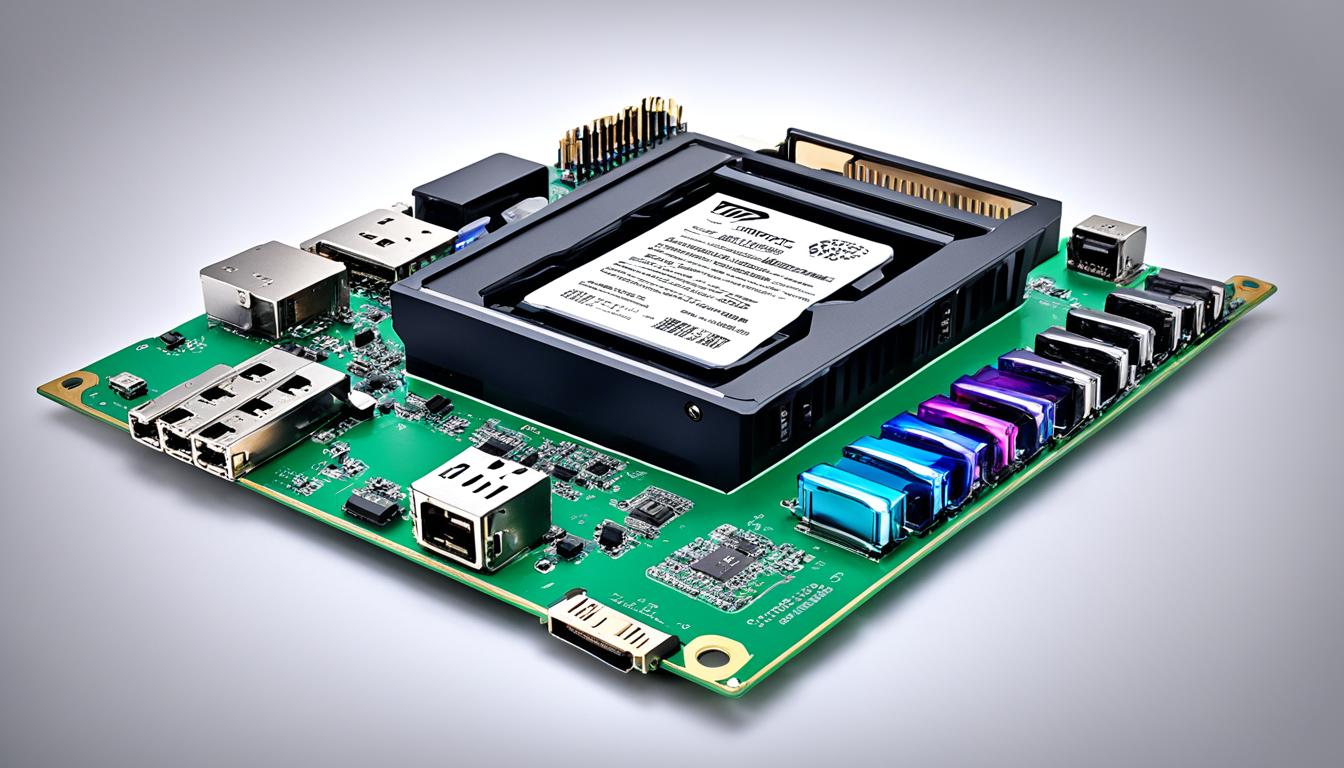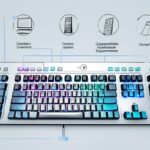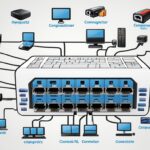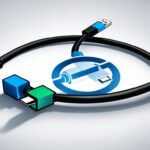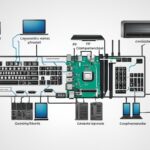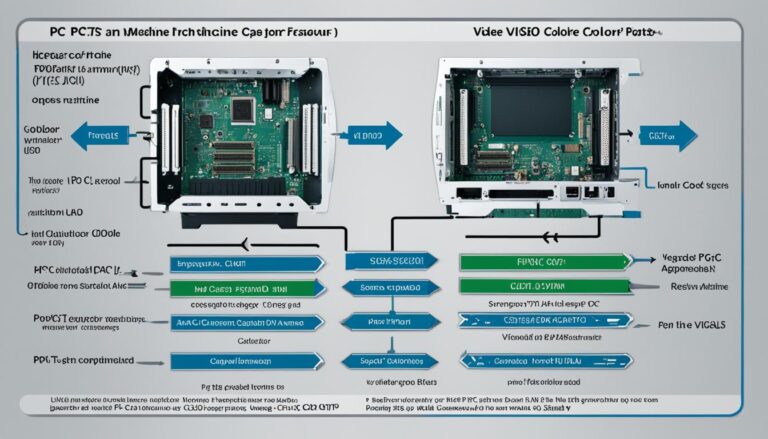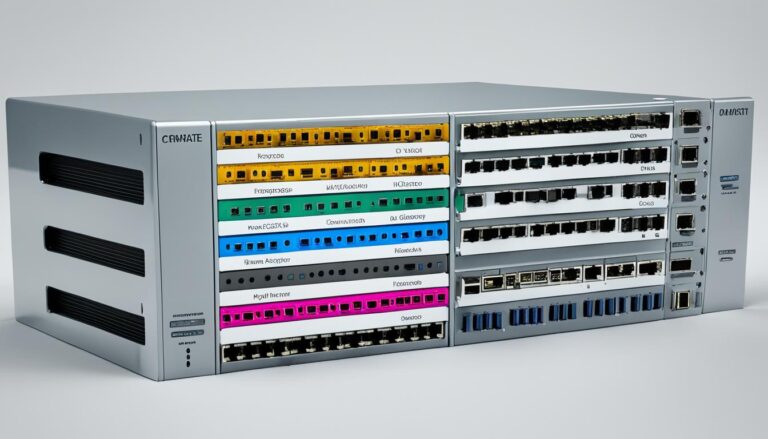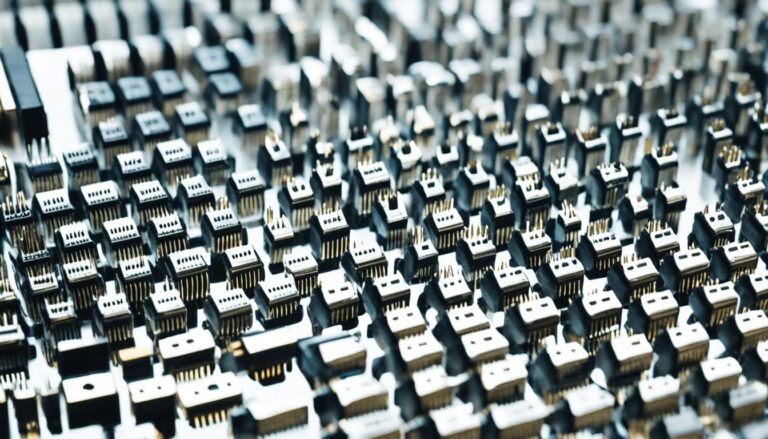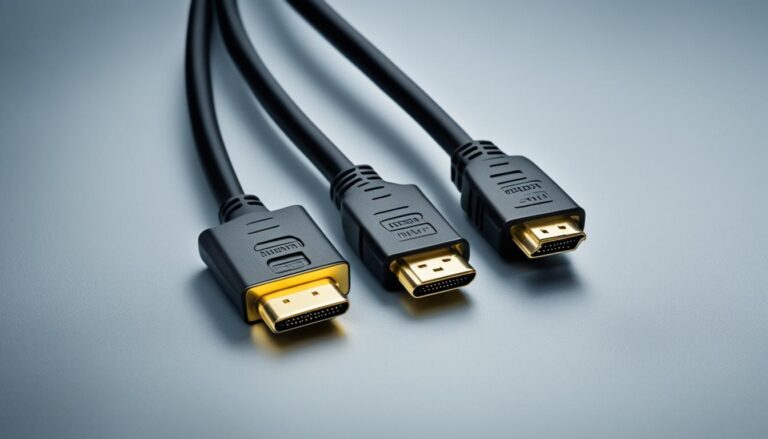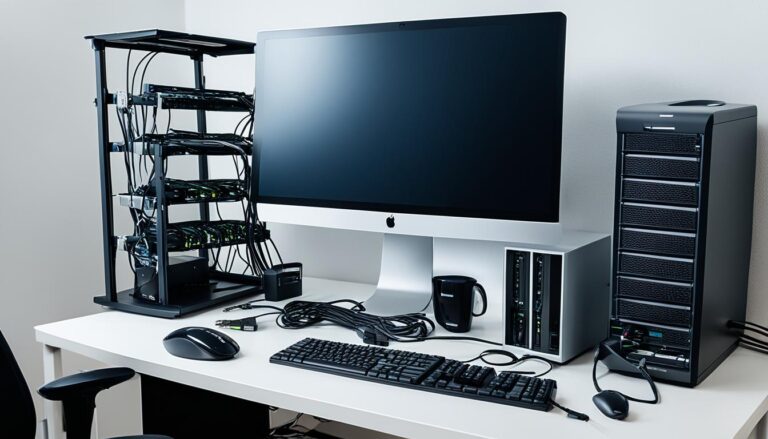USB ports are essential in today’s computer systems. They allow for easy connection of devices like printers and keyboards. This makes using computers much more straightforward.
The beauty of USB ports lies in their “plug and play” capability. You don’t need to struggle with complex setups. The ease of use has made USB the preferred choice for many.
USB ports are also quick. They make transferring files or using external devices faster. This speed is crucial for a seamless computer experience.
Having USB ports in CPUs means wider device compatibility. This lets users connect various peripherals without hassle. It supports everything from printing documents to backing up data effortlessly.
In sum, USB ports are key to modern CPU design. They ensure our digital lives run smoothly. Thanks to their speed, ease of use, and broad compatibility, USB ports greatly enhance how we interact with our devices.
Understanding USB Technology and Types
USB technology is vital for sharing data between a computer and devices. There are many types, each with its own features. Today, we’ll look into USB technology and its versions, like USB 2.0 and USB 3.0.
USB 2.0:
This version improved on the original, USB 1.1. It offers faster data transfer speeds. This means quicker and more reliable data sharing. USB 2.0 works with many devices, from keyboards to high-storage drives. It makes sure you get steady performance, whether you’re working or playing.
USB 3.0:
Known as SuperSpeed USB, USB 3.0 is even faster than USB 2.0. It’s perfect for heavy tasks like moving HD videos or backing up lots of data. USB 3.0 lets you transfer data quickly, helping you save time.
To wrap it up, USB technology keeps getting better to support our computing needs. USB 2.0 gives us good speed and reliability for many devices. USB 3.0 ups the game with its super-fast speeds, great for demanding tasks and large data moves.
| Type | Speed | Bandwidth Support |
|---|---|---|
| USB 2.0 | High | Both low-bandwidth and high-bandwidth devices |
| USB 3.0 | SuperSpeed | Ideal for high-bandwidth tasks and large data transfers |
How USB Ports Work
USB ports are key in sending data between computers and devices. They make connectivity smooth and boost user experiences. Let’s look closer at this vital tech.
Transferring Data in Packets
Data through USB ports gets split into smaller bits called packets. These packets carry crucial info, like where the data is heading. This way, USB ports handle data smartly, making transfer fast and reliable.
Multiple Modes for Different Data Transfers
USB ports use different modes for varying data types. Bulk transfer mode is great for moving lots of data. This mode handles big data chunks well.
There’s also a mode for small packets. It’s used for crucial connections, keeping them stable. USB ports also handle control packets. These are mainly for USB upkeep, like chatting with the CPU for updates.
Plus, there’s an isochronous mode for live audio and video. It keeps the data flow consistent. This is crucial for video calls or streaming.
Bandwidth Allocation
USB ports manage multiple devices by sharing bandwidth. The USB host controller shares out this bandwidth smartly. It ensures every device connects well without slowing the system.
Getting how USB ports work shows us their importance in data transfer. They’re key for moving files, connecting devices, USB management, or live streaming. USB ports unite devices smoothly.
Let’s now look at the different USB cables and connectors. This will broaden our USB tech knowledge.
Understanding USB Cables
USB cables are essential for linking devices to USB ports. They allow devices and computers to communicate and share data smoothly. Knowing the different types and their uses is crucial.
USB-A
USB-A connectors are very common. You often see them on devices like wired mice, keyboards, and USB drives. They have a rectangular shape and are accepted by many devices.
USB-B
USB-B connectors appear on items like routers and printers. They have a square shape with two beveled corners at the top. These are used for devices needing more power and better data transfer.
Micro USB
Micro USB is a smaller form of USB-A and USB-B. It’s popular in mobile gadgets such as smartphones. Due to their small size, they fit perfectly in these devices while offering good data transfer and charging.
USB Type C
USB Type C is the new kid on the block. It’s meant to take over from USB-A and USB-B. This connector is smaller and can be plugged in any way, making it great for thin devices. USB Type C has faster data speeds and better power delivery. It’s a modern solution for today’s devices.
USB cables come in different versions like USB 2.0 and USB 3.0. USB 2.0 can move data up to 480 Mbps. USB 3.0, or SuperSpeed USB, goes up to 5 Gbps. This means much quicker file transfers.
“USB cables create a vital link. They let us connect easily with our devices.”
It’s important to understand USB cable types to connect devices correctly. From USB-A to the new USB Type C, picking the right cable means a smooth and effective connection. Make sure you choose correctly for the best experience.
| Type | Appearance | Commonly Used For |
|---|---|---|
| USB-A | Rectangular shape with flat front | Wired mice, keyboards, USB sticks |
| USB-B | Square shape with two beveled corners | Routers, computers, printers, game consoles |
| Micro USB | Smaller version of USB-A and USB-B | Smartphones, tablets |
| USB Type C | Smaller, reversible port | Modern devices, thin mobile devices |
The Evolution of USB Technology
USB technology has seen many upgrades, each offering faster data transfers and better features. USB 2.0 and USB 3.0 stand out for their unique benefits.
USB 2.0 was a big step from the earlier USB 1.1. It supports fast data sharing, making it great for connecting different devices. It works with both low and high-bandwidth gadgets. This means things like keyboards and webcams connect smoothly.
Then came USB 3.0, known as SuperSpeed USB. It allows for really quick file transfers. This means moving big files or lots of data is easy and fast. USB 3.0 has changed how we use our tech, making things more efficient.
But, not everyone has switched to USB 3.0 yet. Some reasons include issues working with older tech and other faster options like Light Peak.
Even with new developments, USB 2.0 and 3.0 are still popular. They offer dependable data sharing for many gadgets.
| USB 2.0 | USB 3.0 | |
|---|---|---|
| Speed | High-speed USB | SuperSpeed USB |
| Advantages | Supports low-bandwidth and high-bandwidth devices | Even faster data transfer speeds |
| Use Cases | Keyboards, mice, webcams, storage systems | High-definition videos, large data backups |
Conclusion
USB ports are essential for connecting lots of different devices to computers. The arrival of USB 2.0 and USB 3.0 brought faster data transfer and better performance. These improvements have made working with multiple devices much smoother.
USB cables and connectors are key for different USB ports and gadgets. We have USB-A, USB-B, Micro USB, and USB Type C connectors. They help us hook up various devices easily.
Even though not everyone has switched to USB 3.0, it’s still popular for its quick speeds. USB technology is crucial for linking up things like printers, scanners, and keyboards to computers.
To sum up, USB ports link up all sorts of devices to our computers. USB tech has changed how we move data around. It’s flexible and dependable, making it our first choice for connecting devices.
FAQ
How do USB ports enhance peripheral connectivity on CPUs?
USB ports on CPUs let you connect devices like printers and keyboards. This makes the user experience better by ensuring devices connect easily.
What is USB technology and what are its different types?
USB stands for universal serial bus. It’s a way to connect devices to computers. There are several versions, including USB 2.0 and USB 3.0. USB 2.0 is faster than its older version, USB 1.1. USB 3.0 is known as SuperSpeed USB and offers even quicker data transfers.
How do USB ports work and what are the different modes of USB?
USB ports send data in packets. This means they share information between computers and devices. They work in various modes. For example, bulk transfer for big data, control packets for USB management, and isochronous for live audio and video.
What are the different types of USB cables and connectors?
There are many USB cables like USB-A, USB-B, Micro USB, and USB Type C. USB-A is common for mice and keyboards. USB-B connects to many tech devices.
Micro USB is a smaller version used on mobile devices. USB Type C is the latest. It’s small and replaces USB-A and USB-B on new, thin devices.
How has USB technology evolved over the years?
USB has improved a lot. USB 2.0 speeds up data more than USB 1.1 and works with many devices. USB 3.0, or SuperSpeed USB, is faster still. It’s great for high-definition video and lots of data.
What is the significance of USB ports and cables in peripheral connectivity?
USB ports and cables are key for connecting devices to CPUs. They ensure devices work together smoothly. They support many USB device types. This makes USB technology vital for today’s computers.
